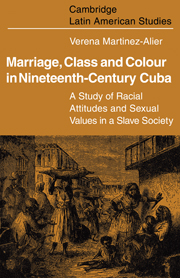 Marriage, Class and Colour in Nineteenth Century Cuba
Marriage, Class and Colour in Nineteenth Century Cuba Book contents
- Frontmatter
- Contents
- Preface
- List of abbreviations
- INTRODUCTION
- PART ONE INTERRACIAL MARRIAGE
- 1 Intermarriage and family honour
- 2 Intermarriage and politics
- 3 Intermarriage and Catholic doctrine
- 4 The white man's view
- 5 Colour as a symbol of social status
- 6 Intraracial marriage
- PART TWO HONOUR AND CLASS
- Appendix: Three Cuban genealogies
- Notes to the text
- Bibliography
- Index
3 - Intermarriage and Catholic doctrine
Published online by Cambridge University Press: 09 October 2009
- Frontmatter
- Contents
- Preface
- List of abbreviations
- INTRODUCTION
- PART ONE INTERRACIAL MARRIAGE
- 1 Intermarriage and family honour
- 2 Intermarriage and politics
- 3 Intermarriage and Catholic doctrine
- 4 The white man's view
- 5 Colour as a symbol of social status
- 6 Intraracial marriage
- PART TWO HONOUR AND CLASS
- Appendix: Three Cuban genealogies
- Notes to the text
- Bibliography
- Index
Summary
the conflict between church and state
The prohibition of interracial marriage and its moral implications had to be of direct concern to the Church. Marriage sanctioned by the Church was the secularly and religiously approved and prescribed form of conjugal union for equals in Spain. Unions between unequals, however, also occurred, or were at least attempted. The alternative in these cases could have been concubinage, as it was in fact in those instances where the social distance between the partners exceeded the accepted boundaries. This alternative was, however, unacceptable to the Church.
As far as the Church was concerned, absolute freedom of marriage existed among Catholics. From the ecclesiastical point of view the State should adhere to the same principle. There had been for some time jurisdictional disputes between the ecclesiastical and secular authorities with regard to marriage. Typical was the conflict that arose when Pope Benedict XIV in 1741, although accepting as licit the secret marriage commonly called ‘of conscience’ instituted by the secular authorities as an alternative in cases of social inequality between the partners, attempted to legislate on its temporal aspects. By proposing that the offspring of these second-class marriages be granted the same civil rights as those of equal marriages, and thus in secular eyes defeating their very aim, he was felt grossly to have exceeded ecclesiastical prerogatives, for ‘regulating inheritance and seeing to contracts is a right held by the civil republic and the authority of the sovereigns and not by the ecclesiastical authorities who should only attend to matters of conscience and the spiritual well-being of souls’.
- Type
- Chapter
- Information
- Marriage, Class and Colour in Nineteenth Century CubaA Study of Racial Attitudes and Sexual Values in a Slave Society, pp. 42 - 56Publisher: Cambridge University PressPrint publication year: 1974


